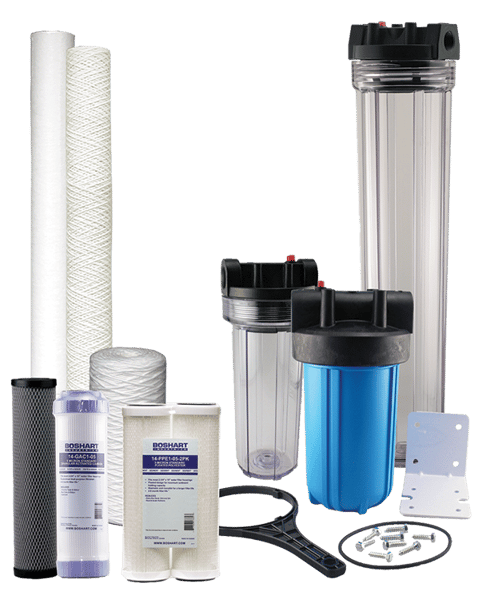THE BASICS ON WATER FILTRATION
There are four basic types of water filtration uses
-
POE (Point-of-Entry)
-
POU (Point-of-Use)
-
Pre & Post Filtration
-
Specialty Applications (high temperature, high pressure, chemical compatibility, commercial & industrial applications)
It is important to remember, if your water source contains unsafe bacteria, this type of filtration will NOT remove it. To filter out unsafe bacteria, you need to use a Reverse Osmosis or UV system that is designed to kill bacteria.
Testing your water will educate you about your water quality issues and give you peace of mind that your water filtration system is providing safe water for you and your family.
.jpg?width=1200&name=WFS1-PP(FI).jpg)
WATER FILTRATION SELECTION 101
1. Identify the Water Quality Issue
Dirt, Rust Particles, Hard Water, Iron, Scale, etc.
2. Determine the type(s) of filter cartridges required to solve the problem
Sediment
Taste & Odour
3. Verify the desired flow rate (Gallons Per Minute)
4. Select cartridge(s) size
Style: Standard or Giant
Length: 10” or 20”
5. Select a filter housing to accommodate the cartridge
6. Select the filter housing features
Bowl Colour: Clear, Blue, Red, Black or White
Bowl Length: 5”, 10", 20”, 30” or 40”
Housing Style: Slim, Standard, Valve-In-Head, Giant, High Temperature or Stainless Steel Single Tube
Plastic Threads or Stainless Steel Insert Threads
Line Connection Size

WARNING: Always Test Water. Do not use with water that is microbiologically unsafe or of unknown quality without adequate disinfection before or after the unit.
WATER FILTER CARTRIDGES
There are many water filter cartridges to choose from, but the great thing is that they are broken down into two categories: Sediment or Taste & Odour - making it way easier to choose which is best to fix your water quality issues.
The next thing you are needing to decide on is the micron rating.
Micron Ratings (µm) are an average size of the openings between pieces of the filter media represented in microns.
Really it comes down to: "What is it that you wanting to stop from coming into your water?" The higher the micron rating the more it will let through. Common micron ratings for filters are 100, 75, 50, 25, 10, 5, 1 and 0.5.
Now that you know which water filter cartridge you need to help fix your water quality issues; you really should also consider your desired flow rate.
Flow Rates are based on “clean” cartridge performance. Too often, one mistakenly selects a cartridge that has a flow rate equal to the flow desired or required. This works great for a short time, however as the cartridge loads with sediment (as they are designed to do) the flow rate decreases and the pressure drop across the cartridge increases. This can result in a flow rate that is not acceptable to the home owner in a short period of time, reducing the required six-month change out time.
PRO TIP: A filter cartridge / housing should be selected with a "Gallons Per Minute" Rating that is 2x the desired flow rate. This allows the cartridge to do its job for an extended period before the flow rate or pressure drops to an unacceptable level. This results in the cartridge lasting closer to or up to the six-month change out time for maximum cost efficiency.
WATER FILTERS HOUSINGS
Ever wonder why there are so many different water filter housings on the market?
There's clear, blue, red, black or white bowl colours; 5”, 10", 20”, 30” or 40” bowl lengths; slim, standard, valve-in-head, giant, high temperature or stainless steel single tube housing styles; plastic or stainless steel insert threads; and line connection sizes.
It may seem overwhelming, but since you already picked out your water filter cartridge first, all you need to do is select a filter housing that accommodates your filter cartridge and the features needed for your application.
PRO TIP: To prevent costly repairs or possible water damage, to your filter housing manufacturers strongly recommend that the bowl (or sump) of all plastic housings be replaced periodically: every five years for clear bowl, and every ten years for opaque bowls. Be sure to date any new or replacement bowl for future reference and indicate the next recommended replacement date.
INSTALLATION TIPS
Filter Cartridges and Filter Housings are a somewhat simple product to install if you have some experience with plumbing. Because of this, they are also not too expensive to have installed.
Caution: If you are not comfortable installing these yourself, make sure that you get a certified Plumber to do it for you. If these products are not installed correctly, it may cause future issues.
Here are some tips to remember when installing a Water Filtration System:
-
Install in an area where leakage will not cause property damage, and there is an adequate drain to handle the volume of water the system can produce.
-
Filter housings should not be installed where exposed to direct sunlight or through a window.
-
After you install a new filter, use the air-release button to purge the air that entered the housing, lines, and cartridge during the installation of the new filter cartridge.
-
Change out your cartridge at least every six months to prevent bacteria build-up over time. Make it part of your routine to change your cartridges at the same time as you change your clocks.
-
Run the water for a few minutes after installing a new filter cartridge.
*Disclaimer: The information on this page is intended for basic education. Ensure that you review any part-specific technical and installation data before selecting a product as that documentation will have all relevant info pertaining to that part.
